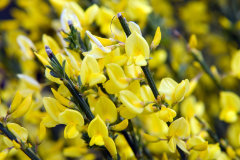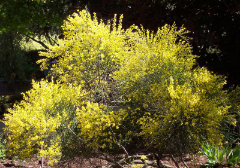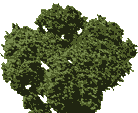 |
|
Creative Commons Attribution-Share Alike 4.0 International license. |
 |
| Creative Commons Attribution 3.0 Unported license. |
Translate this page:
Summary
Cytisus × praecox (Warminster Broom) is a popular ornamental shrub known for its vibrant yellow flowers and low-maintenance requirements. Its uses span across landscaping, ecological purposes, and soil improvement. Several species of Cytisus (commonly known as Brooms) grow in poor soils, are drought tolerant, and thrive in full sun. These plants are typically found in rocky, well-drained soils and withstand long dry periods. They have limited edible uses but contribute to the forest system, making them valuable contributors to healthy, functioning ecosystems. Many brooms fix nitrogen, are suitable for erosion control, act as shelter, forage habitats for wildlife, and contribute to biodiversity. Brooms produce many flowers rich in nectar and pollen, making them valuable for supporting pollinators such as bees, butterflies, and other beneficial insects.
Physical Characteristics

 Cytisus x praecox is a deciduous Shrub growing to 1 m (3ft 3in) by 1 m (3ft 3in) at a fast rate.
Cytisus x praecox is a deciduous Shrub growing to 1 m (3ft 3in) by 1 m (3ft 3in) at a fast rate.
See above for USDA hardiness. It is hardy to UK zone 6 and is not frost tender. The flowers are pollinated by Insects, Bees. The plant is self-fertile.
It can fix Nitrogen.
It is noted for attracting wildlife.
Suitable for: light (sandy) and medium (loamy) soils, prefers well-drained soil and can grow in nutritionally poor soil. Suitable pH: mildly acid, neutral and basic (mildly alkaline) soils and can grow in very alkaline soils.
It cannot grow in the shade. It prefers dry or moist soil and can tolerate drought.
UK Hardiness Map
US Hardiness Map
Synonyms
C. × praecox f. albus (T.Sm.) Rehder. C. × praecox albus T.Sm. C. × praecox f. luteus (T.Sm.) Rehder. C. × praecox luteus T.Sm. Genista × praecox Rob.
Plant Habitats
Edible Uses
References More on Edible Uses
Medicinal Uses
Plants For A Future can not take any responsibility for any adverse effects from the use of plants. Always seek advice from a professional before using a plant medicinally.
None Known
References More on Medicinal Uses
The Bookshop: Edible Plant Books
Our Latest books on Perennial Plants For Food Forests and Permaculture Gardens in paperback or digital formats.

Edible Tropical Plants
Food Forest Plants for Hotter Conditions: 250+ Plants For Tropical Food Forests & Permaculture Gardens.
More

Edible Temperate Plants
Plants for Your Food Forest: 500 Plants for Temperate Food Forests & Permaculture Gardens.
More

More Books
PFAF have eight books available in paperback and digital formats. Browse the shop for more information.
Shop Now
Other Uses
Agroforestry uses:
Broom can be used as a nitrogen-fixing plant, improving soil fertility. It can also be utilized as a ground cover to prevent erosion and is often used in hedgerows and wildlife habitats.
Ornamental Uses: Landscaping-Grown for its prolific spring blooms, create a striking visual display of bright yellow flowers. It is commonly planted in rock gardens and borders or as a feature plant in mixed shrub plantings. It is also used in slopes and embankments for its spreading habit and ability to soften hard lines in landscaping designs. Aesthetic Value: Its fine, green, twig-like foliage offers year-round structure and visual interest, even in winter. Pairs well with other Mediterranean and drought-tolerant plants like lavender and rosemary. Erosion Control and Soil Stabilization: Spreading growth habit and deep root system make it effective for Preventing soil erosion on slopes or banks and Stabilizing disturbed or sandy soils. Low-Maintenance Gardening. Drought-Tolerant Landscapes Ideal for xeriscaping (low-water-use gardens) due to its ability to thrive in dry conditions once established. Windbreaks and Privacy: Its dense growth makes it a useful low hedge or windbreak in exposed areas. Cautions: While it has many benefits, its ability to thrive in poor soils and spread aggressively in some conditions means care should be taken to prevent unwanted growth, especially in sensitive ecosystems. Warminster Broom (C. x praecox) has profuse yellow or cream-coloured flowers rich in nectar and pollen, making them valuable for supporting pollinators such as bees, butterflies, and other beneficial insects. Several species of Cytisus (commonly known as Brooms) grow in poor soils, are drought tolerant, and thrive in full sun. These plants are typically found in rocky, well-drained soils and withstand long dry periods. They have limited edible uses but contribute to the forest system, making them valuable contributors to healthy, functioning ecosystems. Many brooms fix nitrogen, are suitable for erosion control, act as shelter, forage habitats for wildlife, and contribute to biodiversity. Brooms produce many flowers rich in nectar and pollen, making them valuable for supporting pollinators such as bees, butterflies, and other beneficial insects. Nectary - Flowers rich in nectar and pollen: Broom species produce flowers with nectar and pollen that attract bees, butterflies, and other pollinators. Wildlife - Food (Fruit, Seeds, Leaf litter, Shelter, Nesting, Roosting): Broom shrubs provide shelter for wildlife, and birds may use the dense foliage for nesting and roosting. However, the seeds are generally not a significant food source for many animals, and the plant does not produce abundant leaf litter. Invertebrate Shelter (Overwintering sites, Leaf litter, Groundcover): The dense growth of broom can provide shelter for invertebrates, though it is not typically known for its leaf litter or groundcover characteristics. Pest Confuser (Smell): Broom plants do not have a strong scent that confuses pests.
Special Uses
References More on Other Uses
Cultivation details
Soil Texture: Prefers light (sandy) or medium soils. Adapts well to poor, rocky, or gravelly soils. Soil Moisture: Thrives in dry to moderately moist soils. It is drought-tolerant once established but does not tolerate waterlogging. Drainage: Requires well-drained soil to prevent root rot and other moisture-related issues. Soil pH: Tolerates various pH levels, including slightly acidic to alkaline soils. Saline Tolerance: Low tolerance for saline conditions and unsuitable for highly saline soils. Tolerance of Poor Soil: Due to its nitrogen-fixing ability, it thrives in poor, nutrient-deficient soils. Light Requirements: Requires full sun for optimal growth and flowering. Does not tolerate shade well. Height: Typically grows to about 1–1.5 meters (3–5 feet) tall, with a similar spread, forming a compact, arching shrub. Pollination: Pollinated by bees and other insects attracted to its fragrant, pea-like flowers. Temperature: Hardy and thrives in USDA zones 5–8, tolerating frost and cooler climates. Drought Tolerance: Highly drought-tolerant once established, making it suitable for xeriscaping. Flowering: Produces masses of pale yellow, fragrant flowers in late spring to early summer. The flowers often cover the plant, creating a striking ornamental display. Nitrogen Fixation: Improves soil quality by fixing atmospheric nitrogen, making it beneficial for degraded soils. Pests and Diseases: Generally pest-free and resistant to most diseases, but ensure good drainage to prevent root issues. Pruning: Prune lightly after flowering to maintain shape and encourage bushier growth. Avoid heavy pruning into old wood, as it may not regenerate. Fire Hazard: Like other broom species, brooms can be flammable due to their woody stems and dry seed pods, which increases fire risk, especially in arid climates. Its parents are Cytisus multiflorus (the white Spanish broom) and Cytisus oromediterraneus (the Pyrenean broom). The hybrid formula of this artificial cross is C. multiflorus × C. oromediterraneus [2-5]. A deciduous shrub.
References Carbon Farming Information and Carbon Sequestration Information
Temperature Converter
Type a value in the Celsius field to convert the value to Fahrenheit:
Fahrenheit:
The PFAF Bookshop
Plants For A Future have a number of books available in paperback and digital form. Book titles include Edible Plants, Edible Perennials, Edible Trees,Edible Shrubs, Woodland Gardening, and Temperate Food Forest Plants. Our new book is Food Forest Plants For Hotter Conditions (Tropical and Sub-Tropical).
Shop Now
Plant Propagation
Easily from semi-hardwood cuttings or seeds, though seeds may require scarification for better germination.
Other Names
If available other names are mentioned here
Native Range
This is an artificial hybrid.
Weed Potential
Right plant wrong place. We are currently updating this section.
Please note that a plant may be invasive in one area but may not in your area so it's worth checking.
As a hybrid, Cytisus × praecox is non-invasive and lacks the aggressive spreading behaviour of some Cytisus species.
Conservation Status
IUCN Red List of Threatened Plants Status : Not Available

Growth: S = slow M = medium F = fast. Soil: L = light (sandy) M = medium H = heavy (clay). pH: A = acid N = neutral B = basic (alkaline). Shade: F = full shade S = semi-shade N = no shade. Moisture: D = dry M = Moist We = wet Wa = water.
Now available:
Food Forest Plants for Mediterranean Conditions
350+ Perennial Plants For Mediterranean and Drier Food Forests and Permaculture Gardens.
[Paperback and eBook]
This is the third in Plants For A Future's series of plant guides for food forests tailored to
specific climate zones. Following volumes on temperate and tropical ecosystems, this book focuses
on species suited to Mediterranean conditions—regions with hot, dry summers and cool, wet winters,
often facing the added challenge of climate change.
Read More
Expert comment
Author
Bean
Botanical References
Links / References
For a list of references used on this page please go here
Readers comment
| Add a comment |
|
If you have important information about this plant that may help other users please add a comment or link below. Only comments or links that are felt to be directly relevant to a plant will be included. If you think a comment/link or information contained on this page is inaccurate or misleading we would welcome your feedback at [email protected]. If you have questions about a plant please use the Forum on this website as we do not have the resources to answer questions ourselves.
* Please note: the comments by website users are not necessarily those held by PFAF and may give misleading or inaccurate information.
To leave a comment please Register or login here All comments need to be approved so will not appear immediately.
|
Subject : Cytisus x praecox
|
|
|
|